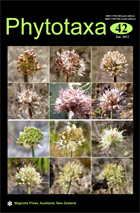Abstract
Morphological and DNA-based characters distinguish a new diploid species centered in the Intermountain Region of the western United States, Navarretia furnissii, from N. saximontana, which is tetraploid. The two species are reciprocally monophyletic in analyses of chloroplast DNA sequences and nrDNA ITS sequences. Navarretia furnissii, presently known from Utah, Idaho, Wyoming, Montana, and Colorado, is distinguished morphologically from N. saximontana by a smaller corolla, greater frequency of pronged calyx lobes, and fewer seeds. A key to Navarretia of the Intermountain Region is presented.

